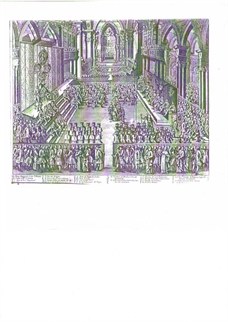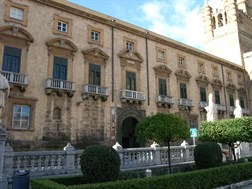Piazza Bologni, the Cathedral and the archbishop’s palace
 The Viceroy makes another stop at Piazza Bologni. The square takes its name from the family of Palermo magistrates who live there. Finally, the viceroy arrives at the cathedral (Figure 1). Nowadays it is now impossible to include the main church of Palermo among examples of Baroque art: outside, the appearance is certainly medieval, the decorative layout was designed in 1767 by Ferdinando FugaFerdinando Fuga (1699-1782) was an architect from Florence, but active mainly in Rome (Palazzo della Consulta, Church of Santa Maria dell’Orazione e Morte and the façade of the Basilica of Saint Mary Major, etc.) and in Naples (Real Albergo dei Poveri, the façade of the church of the Girolamini, etc.). Over the years his style gradually shifted from Baroque to Neoclassical. He died in Naples before being able to implement his project of the restoration of the Cathedral of Palermo.. But the cathedral is the place where the most important political Baroque ceremony took place, the taking of possession, the oath of allegiance to the laws and customs of the kingdom and the blessing of the viceroy by the Archbishop. To celebrate this solemnity the decorations on the outside are not spared, while inside a rigid protocol regulates the positions of those present:
The Viceroy makes another stop at Piazza Bologni. The square takes its name from the family of Palermo magistrates who live there. Finally, the viceroy arrives at the cathedral (Figure 1). Nowadays it is now impossible to include the main church of Palermo among examples of Baroque art: outside, the appearance is certainly medieval, the decorative layout was designed in 1767 by Ferdinando FugaFerdinando Fuga (1699-1782) was an architect from Florence, but active mainly in Rome (Palazzo della Consulta, Church of Santa Maria dell’Orazione e Morte and the façade of the Basilica of Saint Mary Major, etc.) and in Naples (Real Albergo dei Poveri, the façade of the church of the Girolamini, etc.). Over the years his style gradually shifted from Baroque to Neoclassical. He died in Naples before being able to implement his project of the restoration of the Cathedral of Palermo.. But the cathedral is the place where the most important political Baroque ceremony took place, the taking of possession, the oath of allegiance to the laws and customs of the kingdom and the blessing of the viceroy by the Archbishop. To celebrate this solemnity the decorations on the outside are not spared, while inside a rigid protocol regulates the positions of those present:
 «Pigliata Sua Eccellenza l’acqua benedetta dataci Don Francesco Abisso Ciantro d’essa chiesa, intonato il Te Deum laudamus dall’istesso Ciantro si incominciò a sparare una gran quantità di folgore, e con sono di organi e musica si sequitò il Te Deum laudamus e doppo che detto Archivescono hebbe ricevuto Sua Eccellenza si caminò verso l’altare maggiore […]; arrivati all’altare Sua Eccellenza si ingenocchiò sopra un sgabello d’altezza d’un palmo sotto il quale era uno strato di brocato a fare oratione, e finito il Te Deum laudamus si alzò in piedi e si coprì, in questo fece dare dal suo Secretario la patente di Sua Maestà al Prothonotaro del Regno e doppo d’haverla letta ad alta voce si accostò a Sua Eccellenza il quale inginocchiatosi con ambidue li ginocchi, scoperto, posto le mani supra del libro dell’evangeli in mano del Prothonotaro suddetto giurò nella forma solita, et alzatosi in piedi, havendosi coperto se li fece innanzi il Pretore con il libro de privileggi della Città e Sua Eccellenza cossì coperto in piedi posta una mano supra quello giurò per l’osservanza di essi del modo che hanno giurato li suoi predecessori, e fatto il suddetto tornò di nuovo detta musica, e suoni d’organo con sparamento di folgori.»
«Pigliata Sua Eccellenza l’acqua benedetta dataci Don Francesco Abisso Ciantro d’essa chiesa, intonato il Te Deum laudamus dall’istesso Ciantro si incominciò a sparare una gran quantità di folgore, e con sono di organi e musica si sequitò il Te Deum laudamus e doppo che detto Archivescono hebbe ricevuto Sua Eccellenza si caminò verso l’altare maggiore […]; arrivati all’altare Sua Eccellenza si ingenocchiò sopra un sgabello d’altezza d’un palmo sotto il quale era uno strato di brocato a fare oratione, e finito il Te Deum laudamus si alzò in piedi e si coprì, in questo fece dare dal suo Secretario la patente di Sua Maestà al Prothonotaro del Regno e doppo d’haverla letta ad alta voce si accostò a Sua Eccellenza il quale inginocchiatosi con ambidue li ginocchi, scoperto, posto le mani supra del libro dell’evangeli in mano del Prothonotaro suddetto giurò nella forma solita, et alzatosi in piedi, havendosi coperto se li fece innanzi il Pretore con il libro de privileggi della Città e Sua Eccellenza cossì coperto in piedi posta una mano supra quello giurò per l’osservanza di essi del modo che hanno giurato li suoi predecessori, e fatto il suddetto tornò di nuovo detta musica, e suoni d’organo con sparamento di folgori.»
 Once the oath was pronounced, always with a large following, the viceroy leaves the cathedral. Continuing on his way to his residence in Palermo, he passes in front of the archbishop’s palace. In this case it is also a fifteenth-century building (Figure 3), but during the seventeenth century, on the façade of the building there are multiple open and decorated windows: a physical sign, tangible evidence of ecclesiastical power that wants to expand, to be a reference point in the political life of time and that does not hesitate to be in competition with the Viceroy, thanks to the different length of the ecclesiastical dignity of the archbishop’s bishopric compared to the reign of the Viceroy. The first mandate is often lifelong, the second only rarely is prolonged for two periods of three years.
Once the oath was pronounced, always with a large following, the viceroy leaves the cathedral. Continuing on his way to his residence in Palermo, he passes in front of the archbishop’s palace. In this case it is also a fifteenth-century building (Figure 3), but during the seventeenth century, on the façade of the building there are multiple open and decorated windows: a physical sign, tangible evidence of ecclesiastical power that wants to expand, to be a reference point in the political life of time and that does not hesitate to be in competition with the Viceroy, thanks to the different length of the ecclesiastical dignity of the archbishop’s bishopric compared to the reign of the Viceroy. The first mandate is often lifelong, the second only rarely is prolonged for two periods of three years.
